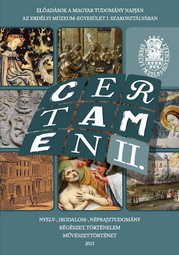Gondolatok a szászfenesi római katolikus templom falképeiről
Ideas about the Floreşti Catholic Church Murals
Author(s): Attila WeiszSubject(s): Cultural history
Published by: Erdélyi Múzeum-Egyesület
Keywords: medieval murals in Transylvania; Florești; Vlaha; Saint George; Saint Catharine from Alexandria; brazen bull; trecento; Gothic linear style
Summary/Abstract: The paper is an iconographical, chronological and stylistic analysis of the Middle Ages murals from the Floreşti Catholic church (Cluj county), including them into the general question of the murals around the city of Cluj. The murals were discovered in 1961–62 by Lajos Bágyuj, and it wasn’t analyzed until yet. The Pieta on the southern façade has totally disappeared because of the inadequate restoration, we know only a picture and a drawing about it. A close analogy of it is the Pieta from the Suatu Unitarian church. The figures are similar in the apostle-gallery in the Bădeşti Calvinist church too, which are dating from the first quarter of the 15th century, and appertains to the style of the international Gothic. The similarities shows maybe the works of the same workshop, which uses a linear style, skinny figures with boned faces and expressive eyes. On the northern wall there were at least two registers of murals. In the upper row, to the right we can see the scene of the Annunciation. The lower row begins with the Kiss of Judas, unfortunately other scenes are unseen. In this moment we have no analogies of it amongst the murals around Cluj, but generally we can declare that it was made in the style of the late international Gothic, and it dates from the middle of the 15th century. In the south-eastern corner of the nave one can see two scenes from the legend of Saint Catharine from Alexandria. This compositions have close analogies in the Şmig Lutheran church (Sibiu county), maybe were copied from there or had a common model. The murals from Şmig, with a better quality, can be dated to the first quarter of the 15th century, which could be orienting to the Floreşti murals, too. At the longitudinal register on the southern wall of the nave one can see the narrative representation of an unidentified saint’s legend. The mural is in a very poor condition, today exists only just a half of the original scenes, and the existing scenes are very stereotypical to many martyrs of the early Christianity. Somewhere in the middle of the longitudinal register is represented the saint in a brazen bull – because the narration keeps on going on the persona survived this kind of execution. There are many early Christian martyrs killed in the brazen bull, only Saint George has been told to survive this. The narrative form of Saint George’s legend was rarely represented in the medieval western art, and amongst them is a real rarity the scene of the brazen bull, but we know some concluding analogies (the murals of Şişterea Calvinist church, Bihor county, the murals of the church of Danish town, Nibe and an altar panel from the Groeninge Museum in Bruges, Belgium). We can include the murals into the style of trecento, which have many examples around Cluj (Saint Michael’s Cluj, Sic Calvinist church, Bădeni Calvinist church, Vlaha Catholic church etc.), painted around 1400.
Journal: Certamen
- Issue Year: 2015
- Issue No: II
- Page Range: 347-364
- Page Count: 18
- Language: Hungarian

